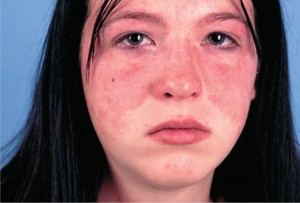Butterfly rash on face are red rashes that spread across the bridge of the nose to the cheeks, similar to a butterfly shape. Butterfly rash is often called malar rash or flush and are more common on patients diagnosed with systemic lupus erythematosus (SLE). The rashes may appear from mild to severe and may occur on other parts of the body as well.
Causes of Butterfly Rash on Face
Here are the different causes of butterfly rash:
• Systemic Lupus Erythematosus (SLE or Lupus)
Lupus is an autoimmune inflammatory disease that occurs when tissues and body organs are attacked by the body’s very own immune system. The body produces abnormal antibodies, that instead of fighting infections, they attack the tissues or organs resulting to various internal diseases including skin manifestation. Almost 65% of lupus patients develop butterfly rash on face.
• Dermatomyositis (DM)
Dermatomyositis is a rare muscle condition that is characterized by muscle weakness and accompanied by distinct skin rashes. Rashes may appear on any part of the body that is more exposed to the sun, most especially in the nose, eyelids and cheeks.
• Bloom Syndrome (Congenital Telangiectatic Erythema)
Bloom Syndrome is a genetic disorder that is characterized by light sensitivity (photosensitivity), short stature, small red blotches on the face (similar to a butterfly shape), and immune deficiency.
• Rosacea
Rosacea is a long term skin condition that is characterized by red, small bumps that spread around the face particularly in the nose, cheeks, chin, and forehead. These bumps are often mistaken as acne but Rosacea has no whiteheads or blackheads and is definitely not squeezable. Though Rosacea may look harmless at first but if left untreated, may worsen and the rashes may flare up in weeks, months or even years.
• Erysipelas
Erysipelas is a severe bacterial infection that spreads within the skin tissues. It is characterized by bright, red, and shiny patches that can be hot and swollen. These rashes are often found in the face than in the lower extremities and other parts of the body.
• Seborrheic Dermatitis
Seborrheic dermatitis is characterized by greasy and scaly patches that usually start in the scalp and spread to the face and to the other “upper” body parts. There is no known cause for this condition but treatments are available to help remove or loosen the scales and crusts. If left untreated, an infection may develop which leave skin extremely itchy and inflamed and may severely spread throughout the body.
• Pellagra
Pellagra is a disease caused by severe vitamin deficiency particularly in niacin and tryptophan. Affected individuals are either unable to absorb niacin in their bodies or their daily food diet lacks the essential vitamins. This condition will result to skin rashes and malnutrition that if left untreated, may get worse and possibly lead to death.
Treatments for butterfly rash in face are available depending on the underlying cause. Butterfly rash on face tend to get worse when exposed to direct sunlight so it is best to avoid the sun as much as possible, drink plenty of water, get enough rest, and eat healthy foods particularly those rich in vitamin C.
Butterfly rash pictures
Check out the rash pictures of butterfly rash

